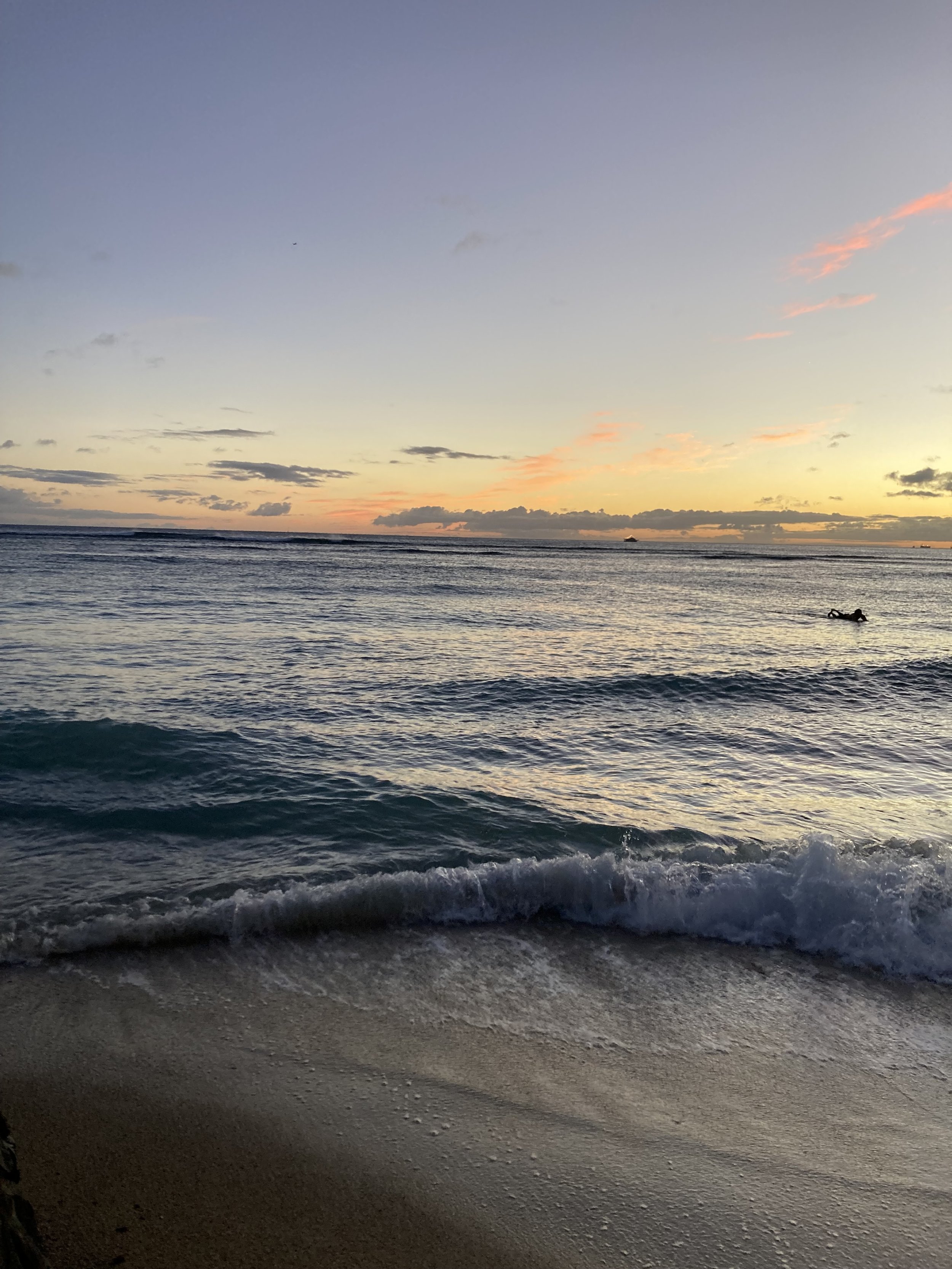A reflection on our summer 2023 visit to Oʻahu
As I stood on the beach with the waves washing over my feet, my mind became quiet and my movements slowed. When a wave recedes, the sand is dark and heavy with the impression of where the wave washed over. This shadow of the wave has a life of its own. It echoes the wave that created it by moving forward as if pulled toward the ocean. This phenomenon hugged my attention like a net. The mark is a memory, a shadow in the sand. I marveled at the way this phenomenon connected to the reason I was in Hawaiʻi.
According to some neuroscience studies, every time you remember a past experience, your mind/body changes in ways that alter future recall (Bridges and Paller 2012). The next time you remember that event, you might not recall the original event but the most recent memory (Paul 2012). In other words, every time I recall my experience on the beach, my mind/body might create a memory of a memory of a memory of the event. This succession or moʻo occurs not just over an individual lifetime, but also over many lifetimes. Like the shore, the bodies of the descendents of institutionalized children might also be dark and heavy with the fading memories of the trauma of incarceration.
The marks of the physical and ideological structures of the colonial institutionalization of children in Hawaiʻi are still visible and textural like the wet shadow in the sand. For example, when we walked through the trees at Waialeʻe, I recognized the concrete base of the windmill from historical photographs of the Boy’s Industrial School at Waialeʻe. Kawela Farrant also pointed out numbers carved into the concrete of a structure used by the Boy’s Industrial School at Waialeʻe. Kawela suggested that the numbers might be inmate numbers assigned to children. In particular, I was struck by a carving which read “591-Kid.” Later, in the Hawaiʻi State archives, I found a roster of children held at the Boy’s Industrial School at Waialeʻe with a column of 3-digit inmate numbers. This roster also included information about why each child was sent there. For example, a 13 year-old Native Hawaiian child was committed for “no less than 2 years” for being “an idle and dissolute child.” Another 12 year-old Native Hawaiian child was committed for “no less than a year” for stealing $1 and a book.
In addition to this roster, two other documents I discovered in the State Archives stood out to me. The first was a record of a meeting of the Territory of Hawaiʻi’s Commision of Insanity in 1913. A young Native Hawaiian woman was diagnosed with “mania a potu” and committed to the Insane Asylum. The Insanity Commission's report says: "Her delusion has mainly been that she is related to almost every Hawaiian she sees...She maintained her delusion as to relationship with all Hawaiians in sight." The report also refers to her relatives in quotes. Such an explicit pathologization of Hawaiian kinship and relationality is notable.
The second document was an investigation into the death of a child at Boy’s Industrial School at Waialeʻe. According to children who were interviewed by the deceased child’s mother, the death was due to medical negligence and abuse from staff. According to the deceased child’s friends, he knew he was very sick and begged to be sent to the hospital but he was repeatedly threatened for asking for help with working in the kalo patch (a punishment at the institution) and being placed in solitary confinement in a dark cell. When he fell asleep while working because he was so sick, a staff member poured water on him to wake him up and punish him for not working. He died soon after. The Boy’s Industrial School at Waialeʻe disputed all the claims of the deceased child’s friends and insisted the death was unpreventable.
The mana or power of these stories is undeniable. One of many definitions of mana in the Hawaiian Dictionary is a “hook used in catching eels.” To me, these mo’olelo are hooks that can be used to catch a much larger story.
Hooks can be used not only to catch, but also to secure something in place. At Waiale’e, Kawela shared some of the kaʻao, or Kānaka Maoli mythology, of the place which relates to this function of fishhooks. According to the ka’ao, Waialeʻe is a part of Kahuku Lewa, a landmass once separate from north Oʻahu (Farrant 2020). Waialeʻe is the location of Kalou, one of two inland ponds which mark the location where Kahuku Lewa was attached to Oʻahu (Farrant 2020). One version of this kaʻao credits the kupua (demigod) Māui with fastening Kahuku Lewa to Oʻahu (Farrant 2020). Another version of this kaʻao credits “two old women guardians,” Lāʻieikawai and Malaekahana, with swimming out to Kahuku, fastening wooden fish hooks to either end of the islet, and reeling it back to shore (Farrant 2020). Kawela beautifully interpreted the ka’ao in the context of his work to restore/refasten a traditional fishpond and kalo lo’i to Waiale’e.
The work our collaborators are engaged in on the ʻāina (land, that which feeds) where these institutions once operated is important for many reasons including that the ʻāina holds forgotten/repressed/suppressed memories. As Sydney Iaukea wrote, “Land, body, and memory all inform one another. The land, extending out and into the ocean, holds the practical and epistemological memories of encounters” (2011). I am deeply grateful for the opportunity to participate in this remembering work and meet so many wonderful people engaged in overlapping work.

